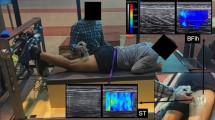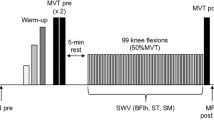Abstract
Introduction
Examination of the mechanical behavior of the hamstrings when acting as antagonists provides information about loading of this muscle group and its role for joint stability during forceful quadriceps contractions. The aim of this study was to quantify biceps femoris long head fascicle length (FL), angle of pennation (PA) and distal tendon/aponeurosis strain during maximum voluntary contraction efforts of the knee extensors using real-time ultrasound.
Methods
Fourteen participants performed passive joint movements and maximum voluntary knee extension and flexion efforts of the knee flexors at 0°, 45° and 90° of knee flexion. An ultrasound probe was used to visualize FL, PA and tendon/aponeurosis strain from the distal part of the muscle.
Results
Two-way analysis of variance designs indicated that: (a) antagonist BFlh tendon/aponeurosis strain increased significantly up to 2.77 ± 1.25% relative to rest (p < 0.05). The FL increased non-significantly (2.86 ± 6.81%) while the PA was unaltered during isometric MVC efforts of the knee extensors (p > 0.05) (b) FL, PA and tendon/aponeurosis strain of the BFlh when acting as antagonist were not significantly affected by knee joint angular position (p > 0.05).
Conclusions
Antagonist hamstring function takes the form of a lengthened tendon/aponeurosis, no fascicle shortening and submaximal neural activation. Future research could examine whether exercise interventions that aim to alter tendon/aponeurosis mechanical properties of the hamstrings when acting as antagonists are beneficial for injury prevention and rehabilitation.





Similar content being viewed by others
Abbreviations
- BFlh:
-
Biceps femoris long head
- EMG:
-
Electomyography
- FL:
-
Fascicle length
- FLe:
-
Effective fascicle length
- MVC:
-
Maximum voluntary contraction
- LMTU:
-
Muscle–tendon unit length
- PA:
-
Pennation angle
- RMS:
-
Root mean square
- US:
-
Ultrasound
References
Ando R, Taniguchi K, Saito A et al (2014) Validity of fascicle length estimation in the vastus lateralis and vastus intermedius using ultrasonography. J Electromyogr Kinesiol 24:214–220. https://doi.org/10.1016/j.jelekin.2014.01.003
Baratta R, Solomonow M, Zhou BH et al (1988) Muscular coactivation. The role of the antagonist musculature in maintaining knee stability. Am J Sports Med 16:113–122
Bennett HJ, Rider PM, Domire ZJ et al (2014) Heterogeneous fascicle behavior within the biceps femoris long head at different muscle activation levels. J Biomech 47:3050–3055. https://doi.org/10.1016/j.jbiomech.2014.06.032
Chleboun GS, France AR, Crill MT et al (2001) In vivo measurement of fascicle length and pennation angle of the human biceps femoris muscle. Cells Tissues Organs 169:401–409
Diong J, Herbert RD, Kwah LK et al (2012) Mechanisms of increased passive compliance of hamstring muscle-tendon units after spinal cord injury. Clin Biomech 27:893–898. https://doi.org/10.1016/j.clinbiomech.2012.07.003
Fukunaga T, Kawakami Y, Kuno S et al (1997) Muscle architecture and function in humans. J Biomech 30:457–463
Fukutani A, Misaki J, Isaka T (2017) Relationship between joint torque and muscle fascicle shortening at various joint angles and intensities in the plantar flexors. Sci Rep. https://doi.org/10.1038/s41598-017-00485-1
Gazendam MG, Hof AL (2007) Averaged EMG profiles in jogging and running at different speeds. Gait Posture 25:604–614
Haberfehlner H, Maas H, Harlaar J et al (2016) Freehand three-dimensional ultrasound to assess semitendinosus muscle morphology. J Anat 229:591–599. https://doi.org/10.1111/joa.12501
Hannah R, Minshull C, Smith SL, Folland JP (2014) Longer electromechanical delay impairs hamstrings explosive force versus quadriceps. Med Sci Sport Exerc 46:963–972. https://doi.org/10.1249/MSS.0000000000000188
Herbert RD, Crosbie J (1997) Rest length and compliance of non-immobilised and immobilised rabbit soleus muscle and tendon. Eur J Appl Physiol 76:472–479. https://doi.org/10.1007/s004210050277
Herbert RD, Moseley AM, Butler JE, Gandevia SC (2002) Change in length of relaxed muscle fascicles and tendons with knee and ankle movement in humans. J Physiol 539:637–645
Herzog W, Leonard TR (2002) Force enhancement following stretching of skeletal muscle: a new mechanism. J Exp Biol 202:1275–1283. https://doi.org/10.1016/S0021-9290(97)00079-1
Higashihara A, Nagano Y, Ono T, Fukubayashi T (2015) Differences in activation properties of the hamstring muscles during overground sprinting. Gait Posture 42:360–364. https://doi.org/10.1016/j.gaitpost.2015.07.002
Hoang PD, Herbert RD, Todd G et al (2007) Passive mechanical properties of human gastrocnemius muscle tendon units, muscle fascicles and tendons in vivo. J Exp Biol 210:4159–4168. https://doi.org/10.1242/jeb.002204
Karamanidis K, Stafilidis S, DeMonte G et al (2005) Inevitable joint angular rotation affects muscle architecture during isometric contraction. J Electromyogr Kinesiol 15:608–616
Kellis E (2003) Antagonist moment of force during maximal knee extension in pubertal boys: effects of quadriceps fatigue. Eur J Appl Physiol 89:271–280
Kellis E (2016) Biceps femoris and semitendinosus tendon/aponeurosis strain during passive and active (isometric) conditions. J Electromyogr Kinesiol 26:111–119. https://doi.org/10.1016/j.jelekin.2015.11.007
Kellis E (2018) Biceps femoris fascicle length during passive stretching. J Electromyogr Kinesiol 38:119–125. https://doi.org/10.1016/j.jelekin.2017.11.015
Kellis E, Baltzopoulos V (1997) The effects of antagonist moment on the resultant knee joint moment during isokinetic testing of the knee extensors. Eur J Appl Physiol Occup Physiol 76:253–259
Kellis E, Baltzopoulos V (1999) In vivo determination of the patella tendon and hamstrings moment arms in adult males using videofluoroscopy during submaximal knee extension and flexion. Clin Biomech 14:118–124
Kellis E, Katis A (2008) Hamstring antagonist moment estimation using clinically applicable models: Muscle dependency and synergy effects. J Electromyogr Kinesiol 18:144–153
Kellis E, Liassou C (2009) The effect of selective muscle fatigue on sagittal lower limb kinematics and muscle activity during level running. J Orthop Sports Phys Ther 39:210–220. https://doi.org/10.2519/jospt.2009.2859
Kellis E, Galanis N, Natsis K, Kapetanos G (2009) Validity of architectural properties of the hamstring muscles: correlation of ultrasound findings with cadaveric dissection. J Biomech 42:2549–2554. https://doi.org/10.1016/j.jbiomech.2009.07.011
Kellis E, Mademli L, Patikas D, Kofotolis N (2014) Neuromuscular interactions around the knee in children, adults and elderly. World J Orthop 5:469–485. https://doi.org/10.5312/wjo.v5.i4.469
Kellis E, Ellinoudis A, Intziegianni K (2017) Reliability of sonographic assessment of biceps femoris distal tendon strain during passive stretching. Ultrasound Med Biol 43:1769–1779. https://doi.org/10.1016/j.ultrasmedbio.2017.04.018
Kwah LK, Herbert RD, Harvey LA et al (2012) Passive mechanical properties of gastrocnemius muscles of people with ankle contracture after stroke. Arch Phys Med Rehabil 93:1185–1190. https://doi.org/10.1016/j.apmr.2012.02.009
Muraoka T, Muramatsu T, Fukunaga T, Kanehisa H (2004) Influence of tendon slack on electromechanical delay in the human medial gastrocnemius in vivo. J Appl Physiol 96:540–544. https://doi.org/10.1152/japplphysiol.01015.2002
Opar DA, Serpell BG (2014) Is there a potential relationship between prior hamstring strain injury and increased risk for future anterior cruciate ligament injury? Arch Phys Med Rehabil 95:401–405. https://doi.org/10.1016/j.apmr.2013.07.028
Palmer TB, Akehi K, Thiele RM et al (2015) Reliability of panoramic ultrasound imaging in simultaneously examining muscle size and quality of the hamstring muscles in young, healthy males and females. Ultrasound Med Biol 41:675–684. https://doi.org/10.1016/j.ultrasmedbio.2014.10.011
Raiteri BJ, Cresswell AG, Lichtwark GA (2015) Ultrasound reveals negligible cocontraction during isometric plantar flexion and dorsiflexion despite the presence of antagonist electromyographic activity. J Appl Physiol 118:1193–1199. https://doi.org/10.1152/japplphysiol.00825.2014
Silder A, Whittington B, Heiderscheit B, Thelen DG (2007) Identification of passive elastic joint moment-angle relationships in the lower extremity. J Biomech 40:2628–2635. https://doi.org/10.1016/j.jbiomech.2006.12.017
Simoneau EM, Longo S, Seynnes OR, Narici MV (2012) Human muscle fascicle behavior in agonist and antagonist isometric contractions. Muscle Nerve 45:92–99. https://doi.org/10.1002/mus.22257
Thelen DG, Chumanov ES, Hoerth DM et al (2005) Hamstring muscle kinematics during treadmill sprinting. Med Sci Sport Exerc 37:108–114
Timmins RG, Opar DA, Williams MD et al (2014) Reduced biceps femoris myoelectrical activity influences eccentric knee flexor weakness after repeat sprint running. Scand J Med Sci Sports. https://doi.org/10.1111/sms.12171
Van Hooren B, Bosch F (2017) Is there really an eccentric action of the hamstrings during the swing phase of high-speed running? Part I: a critical review of the literature. J Sports Sci 35:2313–2321. https://doi.org/10.1080/02640414.2016.1266018
Acknowledgements
The author would like to thank Dr. Athanasios Ellinoudis and Ms Anna Nousia, for assisting with data collection.
Funding
No funding has been received for this project.
Author information
Authors and Affiliations
Corresponding author
Ethics declarations
Conflict of interest
The author declares that he has no conflict of interest.
Additional information
Communicated by Toshio Moritani.
Rights and permissions
About this article
Cite this article
Kellis, E. Antagonist muscle architecture and aponeurosis/tendon strain of biceps femoris long head during maximal isometric efforts. Eur J Appl Physiol 119, 73–83 (2019). https://doi.org/10.1007/s00421-018-4000-2
Received:
Accepted:
Published:
Issue Date:
DOI: https://doi.org/10.1007/s00421-018-4000-2




